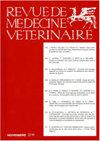Análisis de rentabilidad de la producción de leche de acuerdo con la variación de la fuente de carbohidrato utilizada en el suplemento de vacas holstein
Q2 Veterinary
引用次数: 7
Abstract
In Latin America, Colombia is the fourth largest milk producer. The high cost of food supplies can limit the profitability of this activity. The price of corn as an energy ingredient widely demanded by the food sector and biofuel production is one of the factors that most influences food costs. This work aimed to evaluate the profitability of milk production according to the carbohydrate source used in the supplementation of grazing Holstein cows. Treatment 1 (T1) included corn (Zea mays) as the main source of energy (in the supplement); in Treatments 2, 3, and 4, approximately 50% of the total digestible nutrients (TDN) provided by corn were guaranteed by sorghum (Sorghum vulgare, T2), cassava (Manihot esculenta, T3), and citrus pulp (Citrus sp., T4). Although there were no statistical differences among treatments regarding milk production and compositional quality (p > 0.05), the inclusion of cassava improved the income from milk sales by positively affecting the base price of the product (grams of protein and fat produced). In addition, the inclusion of cassava reduced the cost associated with supplementation and the total cost of production of a liter of milk, which ultimately improved the profitability indicators evaluated. It was the treatment that included citrus pulp that registered lower profitability, due to its lower availability and higher acquisition costs.根据荷斯坦奶牛补充中碳水化合物来源的变化对牛奶生产的盈利能力进行分析
在拉丁美洲,哥伦比亚是第四大牛奶生产国。食品供应的高成本可能限制这一活动的盈利能力。玉米作为粮食部门和生物燃料生产广泛需要的能源原料,其价格是影响粮食成本的最重要因素之一。本研究旨在根据荷斯坦奶牛在放牧过程中所使用的碳水化合物来源来评估产奶的盈利能力。处理1 (T1)以玉米(Zea mays)作为主要能量来源(在补充物中);在处理2、3和4中,高粱(sorghum vulgare, T2)、木薯(Manihot esculenta, T3)和柑橘果肉(citrus sp., T4)保证了玉米提供的总可消化营养(TDN)的50%左右。虽然不同处理之间在牛奶产量和成分质量方面没有统计学差异(p > 0.05),但木薯的加入通过积极影响产品的基本价格(生产的蛋白质和脂肪克数)来提高牛奶销售收入。此外,木薯的加入降低了与补充相关的成本和生产一升牛奶的总成本,最终提高了所评估的盈利指标。由于柑橘果肉的可获得性较低,获取成本较高,因此其盈利能力较低。
本文章由计算机程序翻译,如有差异,请以英文原文为准。
求助全文
约1分钟内获得全文
求助全文
来源期刊

Revue De Medecine Veterinaire
农林科学-兽医学
CiteScore
1.30
自引率
0.00%
发文量
0
审稿时长
18-36 weeks
期刊介绍:
The Revue de Médecine Vétérinaire publishes four kinds of text:
1) Scientific reviews on subjects related to veterinary and comparative medicine. Suggested length: 10 to 30 typed pages.
2) Original reports on fundamental or applied research. Suggested length: 10 to 15 typed pages.
3) Continuous education articles, that should be easily understandable by non-specialists. Suggested length: 10 to 15 typed pages.
4) Clinical reports. Suggested length: 5 to 15 typed pages.
The publication can be done in French language or English language.
For an article written in English by not english native speakers authors, the manuscript must be subjected by attesting that it was read again by an anglophone scientist or a scientific translator.
The authors must certify that the manuscript was not published or subjected for publication to another review.
The manuscript must be accompanied by a sheet signed by all the joint authors indicating their agreement for the tender of the manuscript.
The publication is free but a financial participation could be required for the photographs color. An estimate will be sent to collect the agreement of the authors.
 求助内容:
求助内容: 应助结果提醒方式:
应助结果提醒方式:


